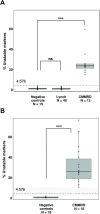High-sensitivity microsatellite instability assessment for the detection of mismatch repair defects in normal tissue of biallelic germline mismatch repair mutation carriers
- PMID: 31494577
- PMCID: PMC7146943
- DOI: 10.1136/jmedgenet-2019-106272
High-sensitivity microsatellite instability assessment for the detection of mismatch repair defects in normal tissue of biallelic germline mismatch repair mutation carriers
Abstract
Introduction: Lynch syndrome (LS) and constitutional mismatch repair deficiency (CMMRD) are hereditary cancer syndromes associated with mismatch repair (MMR) deficiency. Tumours show microsatellite instability (MSI), also reported at low levels in non-neoplastic tissues. Our aim was to evaluate the performance of high-sensitivity MSI (hs-MSI) assessment for the identification of LS and CMMRD in non-neoplastic tissues.
Materials and methods: Blood DNA samples from 131 individuals were grouped into three cohorts: baseline (22 controls), training (11 CMMRD, 48 LS and 15 controls) and validation (18 CMMRD and 18 controls). Custom next generation sequencing panel and bioinformatics pipeline were used to detect insertions and deletions in microsatellite markers. An hs-MSI score was calculated representing the percentage of unstable markers.
Results: The hs-MSI score was significantly higher in CMMRD blood samples when compared with controls in the training cohort (p<0.001). This finding was confirmed in the validation set, reaching 100% specificity and sensitivity. Higher hs-MSI scores were detected in biallelic MSH2 carriers (n=5) compared with MSH6 carriers (n=15). The hs-MSI analysis did not detect a difference between LS and control blood samples (p=0.564).
Conclusions: The hs-MSI approach is a valuable tool for CMMRD diagnosis, especially in suspected patients harbouring MMR variants of unknown significance or non-detected biallelic germline mutations.
Keywords: constitutional mismatch repair deficiency; highly sensitive methodologies; lynch syndrome; microsatellite instability; next generation sequencing.
© Author(s) (or their employer(s)) 2020. Re-use permitted under CC BY-NC. No commercial re-use. See rights and permissions. Published by BMJ.
Conflict of interest statement
Competing interests: None declared.
Figures


Similar articles
-
Diagnosis of Constitutional Mismatch Repair-Deficiency Syndrome Based on Microsatellite Instability and Lymphocyte Tolerance to Methylating Agents.Gastroenterology. 2015 Oct;149(4):1017-29.e3. doi: 10.1053/j.gastro.2015.06.013. Epub 2015 Jun 25. Gastroenterology. 2015. PMID: 26116798
-
A Validated Highly Sensitive Microsatellite Instability Assay Accurately Identifies Individuals Harboring Biallelic Germline PMS2 Pathogenic Variants in Constitutional Mismatch Repair Deficiency.Clin Chem. 2024 May 2;70(5):737-746. doi: 10.1093/clinchem/hvae027. Clin Chem. 2024. PMID: 38531023
-
MSH6-proficient crypt foci in MSH6 constitutional mismatch repair deficiency: reversion of a frameshifted coding microsatellite to its wild-type sequence.Fam Cancer. 2024 Nov;23(4):569-577. doi: 10.1007/s10689-024-00423-x. Epub 2024 Oct 10. Fam Cancer. 2024. PMID: 39387980
-
Cancer prevention by aspirin in children with Constitutional Mismatch Repair Deficiency (CMMRD).Eur J Hum Genet. 2018 Oct;26(10):1417-1423. doi: 10.1038/s41431-018-0197-0. Epub 2018 Jun 14. Eur J Hum Genet. 2018. PMID: 29904176 Free PMC article. Review.
-
[Constitutional MMR deficiency: Genetic bases and clinical implications].Bull Cancer. 2019 Feb;106(2):162-172. doi: 10.1016/j.bulcan.2018.10.008. Epub 2018 Dec 11. Bull Cancer. 2019. PMID: 30551794 Review. French.
Cited by
-
The Challenge of Diagnosing Constitutional Mismatch Repair Deficiency Syndrome in Brain Malignancies from Young Individuals.Int J Mol Sci. 2021 Apr 28;22(9):4629. doi: 10.3390/ijms22094629. Int J Mol Sci. 2021. PMID: 33924881 Free PMC article. Review.
-
An update on central nervous system tumors in germline replication-repair deficiency syndromes.Neurooncol Adv. 2024 Jun 19;6(1):vdae102. doi: 10.1093/noajnl/vdae102. eCollection 2024 Jan-Dec. Neurooncol Adv. 2024. PMID: 39022642 Free PMC article. Review.
-
ERN GENTURIS guidelines on constitutional mismatch repair deficiency diagnosis, genetic counselling, surveillance, quality of life, and clinical management.Eur J Hum Genet. 2024 Dec;32(12):1526-1541. doi: 10.1038/s41431-024-01708-6. Epub 2024 Oct 17. Eur J Hum Genet. 2024. PMID: 39420201 Free PMC article. Review.
-
Report of the sixth meeting of the European Consortium 'Care for CMMRD' (C4CMMRD), Paris, France, November 16th 2022.Fam Cancer. 2024 Nov;23(4):447-457. doi: 10.1007/s10689-024-00403-1. Epub 2024 Jul 20. Fam Cancer. 2024. PMID: 39031223 Free PMC article.
-
Genomic Microsatellite Signatures Identify Germline Mismatch Repair Deficiency and Risk of Cancer Onset.J Clin Oncol. 2023 Feb 1;41(4):766-777. doi: 10.1200/JCO.21.02873. Epub 2022 Oct 14. J Clin Oncol. 2023. PMID: 36240479 Free PMC article.
References
-
- Bakry D, Aronson M, Durno C, Rimawi H, Farah R, Alharbi QK, Alharbi M, Shamvil A, Ben-Shachar S, Mistry M, Constantini S, Dvir R, Qaddoumi I, Gallinger S, Lerner-Ellis J, Pollett A, Stephens D, Kelies S, Chao E, Malkin D, Bouffet E, Hawkins C, Tabori U. Genetic and clinical determinants of constitutional mismatch repair deficiency syndrome: report from the constitutional mismatch repair deficiency Consortium. Eur J Cancer 2014;50:987–96. 10.1016/j.ejca.2013.12.005 - DOI - PubMed
-
- Wimmer K, Kratz CP, Vasen HFA, Caron O, Colas C, Entz-Werle N, Gerdes A-M, Goldberg Y, Ilencikova D, Muleris M, Duval A, Lavoine N, Ruiz-Ponte C, Slavc I, Burkhardt B, Brugieres L, EU-Consortium Care for CMMRD (C4CMMRD) . Diagnostic criteria for constitutional mismatch repair deficiency syndrome: suggestions of the European consortium 'care for CMMRD' (C4CMMRD). J Med Genet 2014;51:355–65. 10.1136/jmedgenet-2014-102284 - DOI - PubMed
-
- Li L, Hamel N, Baker K, McGuffin MJ, Couillard M, Gologan A, Marcus VA, Chodirker B, Chudley A, Stefanovici C, Durandy A, Hegele RA, Feng B-J, Goldgar DE, Zhu J, De Rosa M, Gruber SB, Wimmer K, Young B, Chong G, Tischkowitz MD, Foulkes WD. A homozygous PMS2 founder mutation with an attenuated constitutional mismatch repair deficiency phenotype. J Med Genet 2015;52:348–52. 10.1136/jmedgenet-2014-102934 - DOI - PubMed
Publication types
MeSH terms
Substances
Supplementary concepts
LinkOut - more resources
Full Text Sources
Other Literature Sources
Medical
Miscellaneous
